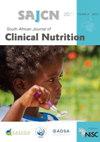Introducing a nutritional risk screening tool in a South African hospital
IF 0.6
Q4 NUTRITION & DIETETICS
引用次数: 2
Abstract
Background Nutritional screening facilitates the early identification of hospitalised children at risk of malnutrition. Screening tools have scarcely been evaluated in the developing world where the burden of malnutrition is greatest. Methods A retrospective study was undertaken of 113 patients admitted to the general paediatric wards at Rahima Moosa Mother and Child Hospital in Johannesburg, South Africa. Children 6 months to 14 years old were screened for malnutrition using anthropometry and correlating WHO z-scores, and retrospectively assessed for nutritional risk using a modified STAMP (mSTAMP). Results The mSTAMP identified additional patients at nutritional risk. The majority (87%) of children with normal anthropometry scored as medium and high risk using the mSTAMP. Weight loss and length of hospital stay (LOS) were higher in medium and high risk groups: One (5%) low risk child lost weight, compared with 8 (38%) medium and 12 (57%) high risk children (p = 0.021). Low risk children had a median LOS of two and half days (IQR 1–8) compared with medium and high risk groups, with medians of three (IQR 3–8) and six (IQR 4–9) days respectively (p = 0.04). Conclusion The mSTAMP identified more children at risk of malnutrition who may not have been considered for nutritional therapy during the hospital stay using anthropometry screening alone. There is a place for nutritional risk screening in developing world settings, but tools may need to be modified locally. Further studies and validation of these tools in sub-Saharan Africa seem prudent and may result in improved nutrition and outcomes of hospitalised children.在南非一家医院推出营养风险筛查工具
背景营养筛查有助于早期发现有营养不良风险的住院儿童。在营养不良负担最重的发展中国家,筛查工具几乎没有得到评估。方法对南非约翰内斯堡Rahima Moosa母婴医院儿科普通病房收治的113名患者进行回顾性研究。使用人体测量法和相关的世界卫生组织z评分对6个月至14岁的儿童进行营养不良筛查,并使用改良STAMP(mSTAMP)对营养风险进行回顾性评估。结果mSTAMP发现了更多有营养风险的患者。大多数(87%)人体测量正常的儿童使用mSTAMP评分为中高风险。中高风险组的体重减轻和住院时间(LOS)更高:一名(5%)低风险儿童体重减轻,而8名(38%)中高风险儿童和12名(57%)高风险儿童(p = 0.021)。与中高风险组相比,低风险儿童的平均LOS为2.5天(IQR 1-8),中位数分别为3天(IQR3-8)和6天(IQR4-9)(p = 0.04)。结论mSTAMP发现了更多有营养不良风险的儿童,这些儿童在住院期间可能没有考虑单独使用人体测量筛查进行营养治疗。在发展中国家的环境中有进行营养风险筛查的地方,但工具可能需要在当地进行修改。在撒哈拉以南非洲对这些工具进行进一步的研究和验证似乎是谨慎的,可能会改善住院儿童的营养和结果。
本文章由计算机程序翻译,如有差异,请以英文原文为准。
求助全文
约1分钟内获得全文
求助全文
来源期刊

South African Journal of Clinical Nutrition
NUTRITION & DIETETICS-
CiteScore
2.50
自引率
9.10%
发文量
21
期刊介绍:
1.The Journal accepts articles from all basic and applied areas of dietetics and human nutrition, including clinical nutrition, community nutrition, food science, food policy, food service management, nutrition policy and public health nutrition. 2.The Journal has a broad interpretation of the field of nutrition and recognizes that there are many factors that determine nutritional status and that need to be the subject of scientific investigation and reported in the Journal. 3.The Journal seeks to serve a broad readership and to provide information that will be useful to the scientific community, the academic community, government and non-government stakeholders in the nutrition field, policy makers and industry.
 求助内容:
求助内容: 应助结果提醒方式:
应助结果提醒方式:


